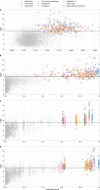Enhancing drug and cell line representations via contrastive learning for improved anti-cancer drug prioritization
- PMID: 38762647
- PMCID: PMC11102516
- DOI: 10.1038/s41698-024-00589-8
Enhancing drug and cell line representations via contrastive learning for improved anti-cancer drug prioritization
Abstract
Due to cancer's complex nature and variable response to therapy, precision oncology informed by omics sequence analysis has become the current standard of care. However, the amount of data produced for each patient makes it difficult to quickly identify the best treatment regimen. Moreover, limited data availability has hindered computational methods' abilities to learn patterns associated with effective drug-cell line pairs. In this work, we propose the use of contrastive learning to improve learned drug and cell line representations by preserving relationship structures associated with drug mechanisms of action and cell line cancer types. In addition to achieving enhanced performance relative to a state-of-the-art method, we find that classifiers using our learned representations exhibit a more balanced reliance on drug- and cell line-derived features when making predictions. This facilitates more personalized drug prioritizations that are informed by signals related to drug resistance.
© 2024. The Author(s).
Conflict of interest statement
The authors declare no competing interests.
Figures




Similar articles
-
MMCL-CDR: enhancing cancer drug response prediction with multi-omics and morphology images contrastive representation learning.Bioinformatics. 2023 Dec 1;39(12):btad734. doi: 10.1093/bioinformatics/btad734. Bioinformatics. 2023. PMID: 38070154 Free PMC article.
-
GraphCDR: a graph neural network method with contrastive learning for cancer drug response prediction.Brief Bioinform. 2022 Jan 17;23(1):bbab457. doi: 10.1093/bib/bbab457. Brief Bioinform. 2022. PMID: 34727569
-
CL-Impute: A contrastive learning-based imputation for dropout single-cell RNA-seq data.Comput Biol Med. 2023 Sep;164:107263. doi: 10.1016/j.compbiomed.2023.107263. Epub 2023 Jul 23. Comput Biol Med. 2023. PMID: 37531858
-
Improving Molecular Contrastive Learning via Faulty Negative Mitigation and Decomposed Fragment Contrast.J Chem Inf Model. 2022 Jun 13;62(11):2713-2725. doi: 10.1021/acs.jcim.2c00495. Epub 2022 May 31. J Chem Inf Model. 2022. PMID: 35638560 Review.
-
Artificial Intelligence for Precision Oncology.Adv Exp Med Biol. 2022;1361:249-268. doi: 10.1007/978-3-030-91836-1_14. Adv Exp Med Biol. 2022. PMID: 35230693 Review.
References
-
- Zou H, Hastie T. Regularization and variable selection via the elastic net. J. R. Stat. Soc. Ser. B: Stat. Methodol. 2005;67:301–320. doi: 10.1111/j.1467-9868.2005.00503.x. - DOI
-
- Morgan HL. The generation of a unique machine description for chemical structures-a technique developed at chemical abstracts service. J. Chem. Doc. 1965;5:107–113. doi: 10.1021/c160017a018. - DOI
Grants and funding
LinkOut - more resources
Full Text Sources

